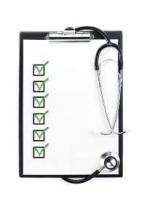The aftermath of a medical error can be an endless tangle of bad feelings, or it can yield valuable lessons for hospital teams.
Adverse events need to be approached as learning opportunities, and a short checklist can start the process, according to Dr. Kimberly D. Manning of Emory University, Atlanta.
She and her colleague Dr. Neil H. Winawer have developed a standardized list of questions for assessing one’s role in adverse events and medical errors. The checklist gets at what went right, what could have been done better, and how to approach similar situations differently in the future.
Taking a standardized approach to medical errors is aimed at bringing more personal accountability into the analysis of adverse events, said Dr. Winawer, director of the hospital medicine unit at Grady Memorial Hospital, Atlanta. "Not every mistake has its origins inside of a system, and there needs to a balance of a no-fault systems culture and accountability," he said.
Dr. Manning added that not every adverse event requires a systems change. "Sometimes it just involves ... sitting down with your team, or alone, and working through exactly what happened to get the lessons and move forward," she said.
The checklist includes a series of must-ask questions, starting with a description of the adverse outcome or pivotal event. Other questions elicit explanations of what the physician did (or did not do) that was not ideal for the patient. And the checklist asks physicians to think about what they did that was good for the patient.
"What we found from having these discussions with our house staff is that the patients we tend to feel the most terrible about are usually the people that we’ve invested a lot into," said Dr. Manning, who is the director of Emory’s transitional year residency program.
It’s important to think about all the high-quality care that was provided, before and after something went wrong, rather than just dwelling on the adverse event, she said.
The checklist also focuses on the future, asking physicians what they could have done differently, what they have learned from the situation, and what safeguards could be implemented to avoid a similar outcome going forward.
The goal is to provide closure, but even more importantly, to honor the patient, Dr. Manning and Dr. Winawer explained.
To help physicians deal with the complex emotions surrounding an adverse event, the checklist includes some follow-up questions. The idea, Dr. Manning said, is to avoid the depression and burnout that can result unless perceived errors in care are discussed and dealt with.
The checklist can be used by individuals or with colleagues as a group. But it’s important to keep in mind that different members of the care team have different levels of responsibility and may have different views about the same event. Sometimes, the intern on the team did everything that he or she could do, Dr. Manning said, but the more senior physician could have done more to help the patient.
Because many adverse events are discovered by colleagues, the checklist also offers an objective way to discuss the problem and minimize some of the awkwardness.
Dr. Manning and Dr. Winawer spoke at the annual meeting of the Society of Hospital Medicine.


